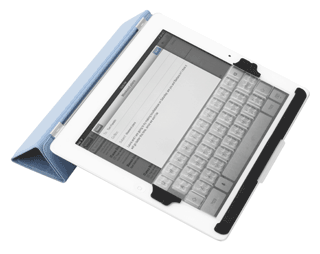Last November, I wrote about TouchFire, a Kickstarter-funded gizmo that aimed to make iPad input comfier, faster and more accurate by letting you type on a clear piece of silicone rubber with cushioned “keys” that sit on top of the iPad’s on-screen ones. At the time, it was supposed to ship in December, but a series of unexpected design and manufacturing challenges–chronicled by its creators on Kickstarter–delayed its release.
TouchFire is finally ready. It’s $49.99, works with all three generations of iPad and is now for sale. The company provided me with one for review.
 The keyboard has undergone some refinements since I tried it last year, but the basic notion is unchanged. It’s still a svelte, flexible sheet of soft keys with a magnetic spine that clings to the Smart Cover magnets embedded in the iPad 2 and new iPad, allowing you to position the sheet accurately over the iPad’s landscape-orientation keyboard in a jiffy. Once there, it clings in place until you choose to remove it.
The keyboard has undergone some refinements since I tried it last year, but the basic notion is unchanged. It’s still a svelte, flexible sheet of soft keys with a magnetic spine that clings to the Smart Cover magnets embedded in the iPad 2 and new iPad, allowing you to position the sheet accurately over the iPad’s landscape-orientation keyboard in a jiffy. Once there, it clings in place until you choose to remove it.
If you’re a touch typist, TouchFire lets your fingers find their proper places on the home row more easily. And if (like me) you’ve got a typing style that’s self-taught and idiosyncratic, it still feels like you’re pressing keys–albeit rather rubbery ones–with a bit of travel rather than thunking your fingertips against an unyielding sheet of glass.
When you’re not typing, you can fold the keyboard back out of the way in about half a second; it’ll sit on the edge of the tablet until you need it again. It comes with two small magnets which you can stick to the inside of a Smart Cover or other iPad tablet to secure it, letting you carry a keyboard that adds nearly no bulk or weight to your iPad setup. (You also get a plastic case.)
TouchFire has at least one direct competitor, iKeyboard, which starts with a similar concept but implements it in stiffer plastic rather than TouchFire’s squishy silicone. (I haven’t tried it.) But people are also going to compare it to Bluetooth iPad keyboards such as Logitech’s Ultrathin. It really doesn’t have that much in common with them, though. It’s far more portable and doesn’t require charging, but it provides a rough approximation of traditional typing feel rather than the real thing, and doesn’t address the fact that the iPad’s on-screen keyboard eats up so much space that you can’t see much of your document.
The bottom line: If you want a conventional external keyboard for your iPad…well, I think you’ll still want one. But if they’re more keyboard than you need, and the iPad’s on-screen one isn’t enough to make you a happy typist, TouchFire might be right for you. It’s certainly an ingenious idea. I’m glad its makers waited to release it until they worked out the kinks–and I’m curious what the thousands of Kickstarter backers who waited so long for the units they pre-ordered think now that they’re getting their hands on them.


